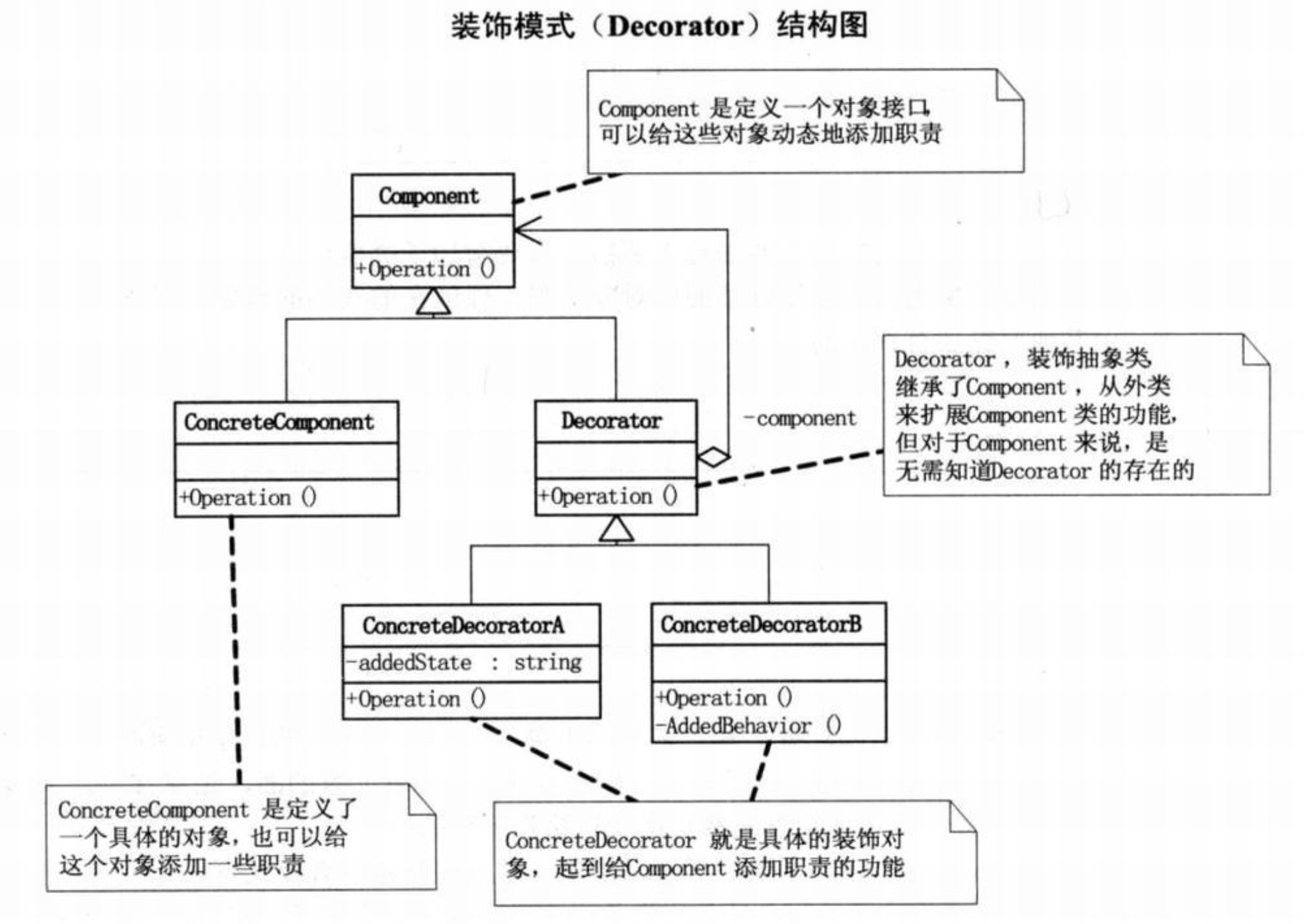# 装饰模式
# 1、基本概念
装饰模式是为已有功能动态的添加更多功能的一种方式
当系统需要新功能的时候,是向旧的类中添加新的代码,这些新加的代码通常装饰了原有类的核心职责或者主要行为。

上述UML图含义如下:Decorator不仅需要实现Component类,并且其内部还需要依赖一个Component类(承载内部Component对象链的起始点),具体的业务根据需要来继承Decorator类
# 2、代码示例
interface Component {
run(): void;
}
class Decorator implements Component {
protected component: Component | null;
constructor(component?: Component) {
this.component = component || null;
}
run(): void {
if (this.component) {
this.component.run();
}
}
decorate(com: Component): Component {
this.component = com;
return this;
}
}
class GotoWork implements Component {
run(): void {
console.log("去上班了,不上班没有钱啊");
}
}
class TakePhotoDecorator extends Decorator {
run(): void {
console.log("拍照,记录下春天美美的花草");
super.run();
}
}
class LookBeautyDecorator extends Decorator {
run(): void {
console.log("男人至死是少年,不看美女怎么行呢");
super.run();
}
}
let work = new GotoWork();
const take = new TakePhotoDecorator();
const look = new LookBeautyDecorator();
work = take.decorate(work);
work = look.decorate(work);
work.run();
上述代码中,我稍微做了一点儿处理,Decorator类的装饰方法返回的是Component,这样就可以把装饰好的结果赋值给最开始的对象(work = take.decorate(work);,改写了初始化的work对象,而不用最终调用look.run方法)最好执行方法的时候,逻辑上看起来比较好理解一些。
或者,我又思考了另外一种实现:
interface Component {
run(): void;
}
class DecorateAbility implements Component {
/**
* 可以根据自己的需要用数组还是用Set来存储装饰类
*/
protected components: Set<Component> = new Set();
run(): void {
this.components.forEach((com) => {
com.run();
});
}
decorate(com: Component) {
// 保证唯一值
this.components.add(com);
}
}
class TakePhotoComponent implements Component {
run(): void {
console.log("拍照,记录下春天美美的花草");
}
}
class LookBeautyComponent implements Component {
run(): void {
console.log("男人至死是少年,不看美女怎么行呢");
}
}
class Work extends DecorateAbility {
run(): void {
super.run();
console.log("要上班啊,不上班怎么有钱呢?");
}
}
const work = new Work();
const take = new TakePhotoComponent();
const look = new LookBeautyComponent();
work.decorate(take);
work.decorate(look);
work.run();
这样,当每次调用decorate方法时,就是在给Work类的实例增加能力,不需要再考虑实例,逻辑上更好理解。
# 3、在前端开发中的实践
装饰模式的思想我们已经领悟到了其关键点—>不修改原本的内容,扩展其能力,但是如果真的把代码写成这样的话,还是比较复杂的。
如果有学习过Spring这类框架的同学一定对AOP(面向切面编程)有所了解,装饰模式就是这个思想,那抓住重点,我们就可以使用AOP来实现装饰模式。
因为JS有自己的语法特性,所以我们实现起来就不必那么绕了。
/**
* 增加前置执行的函数
*/
Function.prototype.beforeExec = function (fn) {
const _this = this;
return function wrapper() {
fn.apply(this, arguments);
return _this.apply(this, arguments);
};
};
/**
* 增加后置执行的函数
*/
Function.prototype.afterExec = function (fn) {
const _this = this;
return function wrapper() {
const response = _this.apply(this, arguments);
fn.apply(this, arguments);
return response;
};
};
为原型绑定这两个函数之后,比如在多人合作开发一个项目时,我们其实不知道window.onload上目前挂载了什么业务逻辑需要处理,但是又不敢贸然直接给window.onload赋值一个新函数,此刻,上述装饰模式的实现方式就派上了大用处。
function onLoad() {
console.log("我想处理一些业务逻辑");
}
// 不需要担心覆盖其它开发者增加的onload事件
window.onload =
typeof window.onload === "function"
? window.onload.beforeExec(onLoad)
: onLoad;
并且,再执行这个操作,仍然可以扩展window.onload回调函数的能力不用担心覆盖之前的内容。
以下是使用装饰模式处理axios请求增加loading提示的例子:
import fetch from "axios";
import Vue from "vue";
/**
* 为请求注入loading
* @param {Function} fn 请求后端的函数
* @param {String} msg loading提示信息
* @returns
*/
function decorate(fn, msg = "") {
return function enhance() {
Vue.prototype.$loading.show(msg);
const result = fn.apply(this, arguments);
if (result && typeof result.then === "function") {
return result
.then((resp) => {
Vue.prototype.$loading.hide();
return resp;
})
.catch(() => {
Vue.prototype.$loading.hide();
});
}
return result;
};
}
/**
* 获取活动配置
*/
export const getAppInfo = decorate(function getAppInfo() {
return fetch("/api/baofang/y2023/y2023/TombSweepingDay0403/index");
});
经过这个装饰函数之后,业务侧只需要关心数据处理逻辑,不用再关注处理页面的提示信息,简化调用。而对于一些不需要loading提示,或者处理比较复杂的loading就不走这个decorate装饰函数,根据业务需要灵活的控制。
在ES5及之前,我们只能通过这种办法实现装饰模式,但是ES6引入了一个新的语法:Decorator(不仅可以增加原对象的能力,还可以削弱原对象的能力),同样可以实现上述方式。
因为Decorator在ES6仍然是一个提案,其语法仍然在变化当中,本文以2020年的装饰器语法进行阐述:
function log(target: Object, name: string, descriptor: PropertyDescriptor) {
var oldValue = descriptor.value;
descriptor.value = function () {
console.log(`Calling ${name} with`, arguments);
return oldValue.apply(this, arguments);
};
return descriptor;
}
class MyClass {
@log
handleClick() {
console.log("用户点击了按钮");
}
}
目前装饰器的语法,上述代码可能已经无法正常运行了。
其实它的思路和我们写的AOP函数是一样的,也是通过重写原函数增强了原函数的能力,未来装饰器的语法何去何从还不得而知,大家就权当看看稀奇吧。